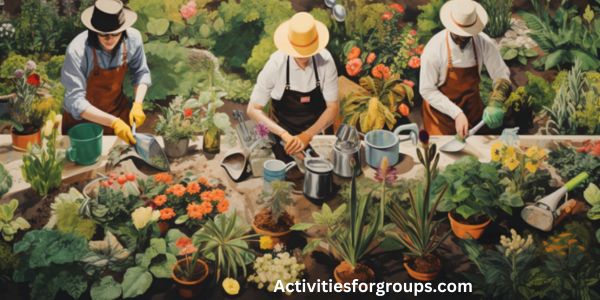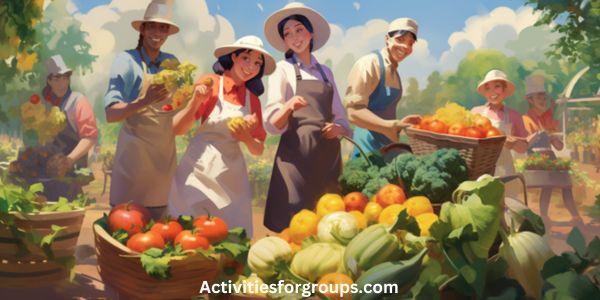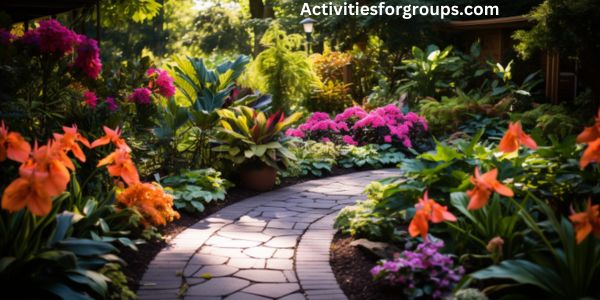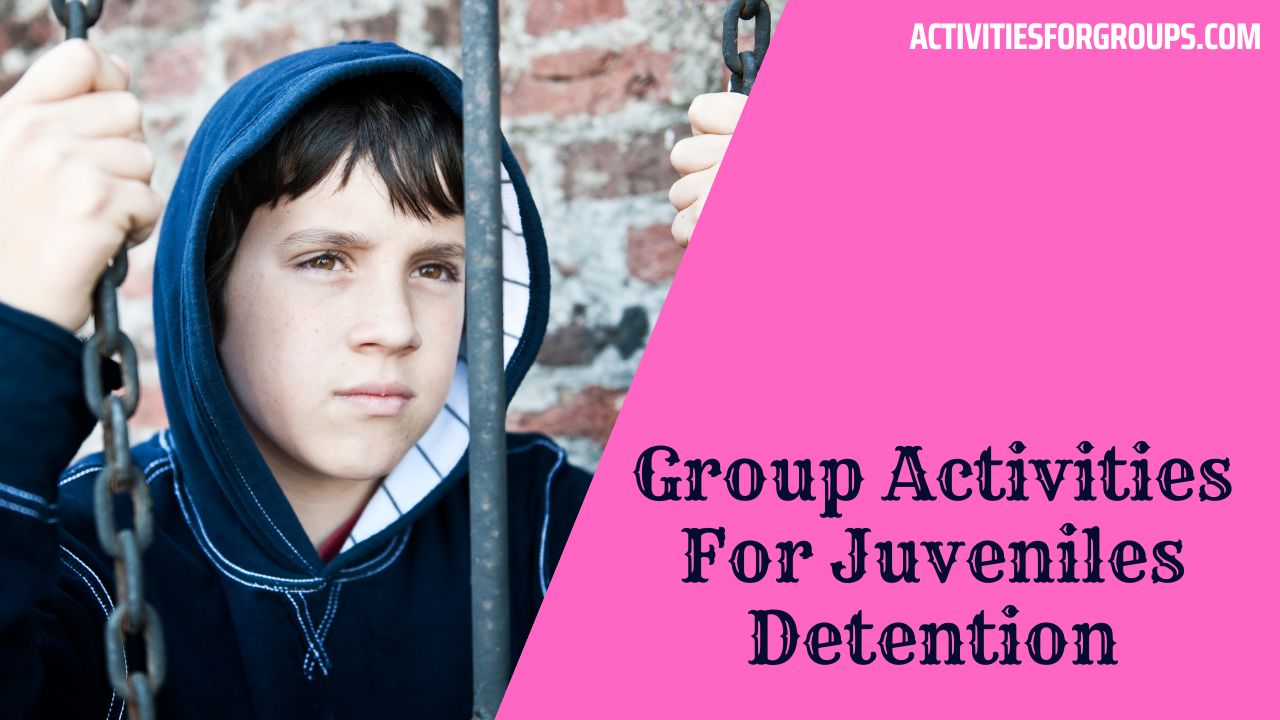Gardening can be a great way to bring a community together. You can create a beautiful outdoor space that everyone can enjoy.
Here are some examples of successful group gardening projects you could try in your own community. From planting trees to creating a botanical garden, there are plenty of ideas to get you started!

Community Gardening in the Park
If you’re looking to get involved in a community gardening project, why not consider starting one in the park? Park community gardens are a great way to bring the community together and create a vibrant outdoor space.
Not only is it a great way to beautify the park, but it’s also a great opportunity to teach kids about nature and the importance of taking care of the environment. Plus, it’s a great way to meet new people and get to know your local community.
Organizing a community park garden is relatively easy. First, you need to decide on the size and shape of the garden and work with your local park authority to secure permission. Once that’s done, you can start recruiting volunteers.
Make sure to spread the word and get the community involved. You can also partner with local businesses to get donations and sponsorships.
Once you have the volunteers and resources, you can start the actual gardening process. Volunteers can help with weeding, planting, and watering the garden. Make sure to create a plan for maintenance so that the garden looks great throughout the year.
Finally, get the word out about your garden. Invite the community to come and enjoy the garden. Have an opening ceremony and invite local politicians and other key figures in the community. This is a great way to show the community the value of the garden and to encourage them to get involved.
Street Beautification With Flowerbeds
Gardening with flowers can be a great way to beautify your street. When planning a group project, it’s important to consider the plant selection as well as involving the local community.
Get creative and find ways to make everyone feel included!
Plant Selection
As you select plants for a street beautification project with flowerbeds, consider the impact of colors, scents, and textures. Think about how these elements can create a vibrant and inviting atmosphere for pedestrians.
Here are four key factors to consider when making plant selections:
- Flowers of different sizes and shapes.
- Foliage that provides texture and contrast to the flower colors.
- Native plants that attract wildlife and beneficial insects.
- Scented plants to create a pleasant environment.
In addition, consider the amount of sun and water the plants need, as well as how much maintenance they require. When making selections, also look for plants that will be in bloom for the longest period of time.
Community Involvement
Your involvement is key to a successful street beautification project with flowerbeds. Consider how you can contribute.
Whether you’re a local business, a school, or a civic organization, there are plenty of ways to get involved. You can make donations of materials, such as soil and plants, and coordinate volunteers for labor.
You can also organize special events or fundraisers to raise money for the project. Additionally, you can reach out to the local government for help and resources.
By involving the whole community in the effort, you can have a greater impact on the project’s success. In some cases, you may even be eligible for grants or tax benefits for your involvement.
Together, you and your community can create something beautiful and meaningful that will benefit everyone.
Creating a Botanical Garden

Creating a botanical garden is a great way to bring people together and create a beautiful, vibrant part of the community.
When planning for such a project, it’s important to consider basics such as location, budget, and maintenance.
Additionally, selecting the right plants for the climate and the soil is crucial for the garden’s success.
Let’s explore these points further.
Planning Basics
You can create a stunning botanical garden with proper planning. Before you get started, take the time to consider the project’s scope, resources, and budget. Here are a few things to keep in mind:
- Select a theme that fits the location and purpose of the garden.
- Choose a variety of plants that are suitable for the environment.
- Develop a realistic plan and timeline for the project.
- Make sure you have the necessary tools and resources.
Planning ahead is essential for success. When you have a clear vision and well-defined goals, you can create an amazing botanical garden that will last for years to come.
Plant Selection
As you choose plants for your botanical garden, consider the climate and soil conditions to ensure success. Recognize the areas of the garden that receive full sun and those that are shadier. Select plants that are suitable for the conditions in which they’ll be grown.
| Plant Name | Sun Requirements | Soil Conditions |
|---|---|---|
| Hibiscus | Full Sun | Moist |
| Impatiens | Partial Shade | Sandy |
| Lavender | Full Sun | Well-drained |
| Hosta | Partial Shade | Moist |
Consider annuals, perennials, ornamental grasses, and shrubs for your garden. Research the different plants and pick those that will thrive in your area. Group plants together that have similar needs so they can form a community. Have fun and be creative in your plant selection.
Planting Trees in the Neighborhood
You’re part of a group that’s committed to planting trees in the neighborhood. Trees are integral to the health of the environment, and planting them can have a positive impact on the entire community. Here are four great reasons why you should consider planting trees in your neighborhood:
- Trees help clean the air by absorbing pollutants and producing oxygen.
- Trees provide shade and help reduce the urban heat island effect.
- Trees can reduce energy costs by blocking sunlight and wind.
- Trees add beauty to the neighborhood and can increase property values.
There are many ways to get started on a group gardening project. You can hold a neighborhood tree planting event, host an educational workshop, or develop a plan to plant trees in certain areas. It’s important to involve everyone in the community and make sure that everyone is on board with the project.
You should also consider the type of trees to plant and their potential impact. Research native species that would be best suited to your climate and soil type. Also, consider trees with long lifespans as they’ll provide the most lasting benefits to the neighborhood. Finally, it’s important to be mindful of the trees’ placement and make sure that they won’t interfere with power lines, sidewalks, or other infrastructure.
With careful planning and community involvement, planting trees in the neighborhood can be a successful and rewarding group gardening project.
Growing Vegetables in Community Gardens
Growing vegetables in community gardens is a great way to bring people together and strengthen the local community. Community gardens have become increasingly popular in cities and towns, as they offer people a chance to come together, share knowledge, and work toward a common goal.
A community garden can provide fresh produce to those who may not have access to it, while also helping to beautify the area.
There are many successful group gardening projects around the world that demonstrate the power of collective action and the importance of collective responsibility.
| Project | Location |
|---|---|
| GrowNYC | New York City, USA |
| Hands On Hartford | Hartford, USA |
| Edible Campus | Melbourne, Australia |
| The People’s Grocery | Oakland, USA |
GrowNYC is a great example of an urban gardening project in New York City. The project aims to create access to fresh food and green space for communities that don’t have access to them. They offer educational workshops, gardening classes, and volunteer opportunities.
Hands On Hartford is an urban gardening project in Hartford, USA, that provides fresh food to people in need while also teaching community members about food production and nutrition. They offer workshops and classes on gardening, composting, and food preservation.
Edible Campus is a community-led urban gardening project in Melbourne, Australia. It brings together local people to create a garden that provides fresh produce to the community. The project also works to promote environmental sustainability and urban greening.
The People’s Grocery in Oakland, USA, is a community-based urban gardening project. The project focuses on providing access to fresh, healthy food to local communities, while also teaching people about food production and nutrition. They provide workshops and classes on gardening, food preservation, and composting.
These group gardening projects are great examples of how collective action can make a difference in local communities. They demonstrate the importance of collective responsibility and the power of collective action to create positive change.
Building Green Spaces in Urban Centers
You can help to build green spaces in urban centers by participating in successful group gardening projects. There are many ways to get involved with a group gardening project, including volunteering to help maintain existing gardens, mentoring new gardeners, and starting a new garden in a previously unused space.
Here are four ways to get started:
- Research local groups: Before you can get involved with a group gardening project, you must first find one. Look for local gardening groups on social media or search online to find out what kind of projects are happening in your area.
- Attend events: Once you have identified some local groups, attend their events to get to know the people involved in the projects. Attendee events to learn more about the organization and how you can help.
- Find out what kind of help is needed: Each group will have different needs, so find out what kind of help is needed. You might be able to volunteer your time to help maintain existing gardens or mentor new gardeners.
- Create a plan: If you decide to start a new garden in an unused space, create a plan for how you’ll go about it. Consider factors such as soil quality, accessibility, and funding before getting started.
Creating a Rain Garden
By joining a group gardening project, you can help create a rain garden. A rain garden is designed to collect, store, and absorb rainwater. It’s typically planted with native plants that can thrive in wet and dry conditions. This type of garden is a great way to reduce runoff, prevent flooding, and protect local waterways.
Creating a rain garden is a great way to get involved in a group gardening project. You can start by identifying a site that can accommodate a rain garden. Consider factors such as the amount of space available, the sun exposure, and the drainage. Once you have a spot, you’ll need to dig the garden and choose suitable plants.
When it comes to plants, look for native varieties that will thrive in wet and dry conditions. Many rain gardens are planted with grasses, wildflowers, and shrubs. You can also add other features to the garden such as bird baths, a water feature, and benches.
When the garden is finished, you can enjoy the results of your hard work. A rain garden is a great way to beautify your neighborhood and help protect the environment. Plus, it’s a great way to bring people together and build a sense of community.
Potted Plant Projects for Patios
Heading out onto your patio with a group of friends to create a potted plant project can be both fun and rewarding. Potted plants are an easy way to add some life and color to your outdoor living area. Here are some tips to get your project off the ground:
- Choose a theme: Pick a color scheme, type of plants, or a specific design aesthetic to form the basis of your project. This will help you create a unified look that will make your patio pop.
- Plan out your design: Take measurements of your patio and sketch out a plan of where each pot will go. This will help you determine the size and quantity of plants you’ll need.
- Create planting beds: Use raised beds to create planting areas for your pots. This will provide you with more control over the soil quality and drainage.
- Choose your plants: Select plants that are suited to your patio’s size, light, and climate. This will ensure that your plants will thrive and look beautiful.
Gardening with friends can be a great way to spend time together and create something beautiful. With some planning and creativity, you can create a stunning potted plant project for your patio.
Designing an Outdoor Landscape for Schools

With the help of a group of volunteers, you can design an outdoor landscape for schools that’s both beautiful and functional. Think of trees, flower beds, and paths that create a safe and inviting environment for students, staff, and visitors. Consider incorporating benches, tables, and other outdoor furniture for students to relax and study during breaks. You could also add a water feature, such as a fountain or pond, for a calming and inviting atmosphere.
When deciding on the design, consider the climate and the local environment. Choose plants that will thrive in the area and make sure they’re low maintenance and require minimal upkeep. Work with the school to determine what type of landscape will best serve the needs of the students and staff.
Before beginning the project, make sure to get permission from the school and the local government. Establish a timeline and ensure that it can be completed in a timely manner. Create a budget and shop around for the best prices for materials.
Once the design is finalized, recruit volunteers to help with the project. Share the project plan with them and assign tasks to ensure that the work is completed safely and efficiently. Track progress and celebrate when the project is completed.
Designing an outdoor landscape for schools is a great way to bring the community together and create a space that’s both beautiful and functional. With the help of volunteers and proper planning, you can create a landscape that everyone will enjoy.
Frequently Asked Questions [FAQs]
What Are the Best Plants to Use for a Community Garden?
You’ll want to select plants that are easy to care for and will thrive in your local climate. Consider using perennials, vegetables, and herbs that are easy to maintain.
What Methods Should Be Used to Ensure a Successful Group Gardening Project?
Plan ahead, coordinate tasks, and communicate regularly to ensure success in your group gardening project. Utilize everyone’s strengths and create a team-oriented atmosphere.
What Type of Maintenance Is Required for a Botanical Garden?
Maintaining a botanical garden requires regular weeding, pruning, fertilizing, pest control, watering, and general cleanup. Also, be sure to monitor for any disease or damage.
What Are the Long-Term Benefits of Planting Trees in the Neighborhood?
Planting trees in your neighborhood can bring you a number of long-term benefits. You’ll get increased shade, cleaner air, and a healthier environment. Plus, they can help reduce noise pollution and stormwater runoff.
How Can Schools Best Design Their Outdoor Landscape for Maximum Sustainability?
Schools should plan an outdoor landscape with sustainable elements like native plants, rain gardens, tree plantings, and composting. These features create a healthy and vibrant environment.
Conclusion
You’ve seen some great examples of successful group gardening projects. From community gardens to green spaces, there’s something for everyone to get involved with.
Gardening is a great way to bring people together, beautify the environment, and provide healthy food.
So gather your friends, get creative, and start working on your own group gardening project today!




Leave a Reply